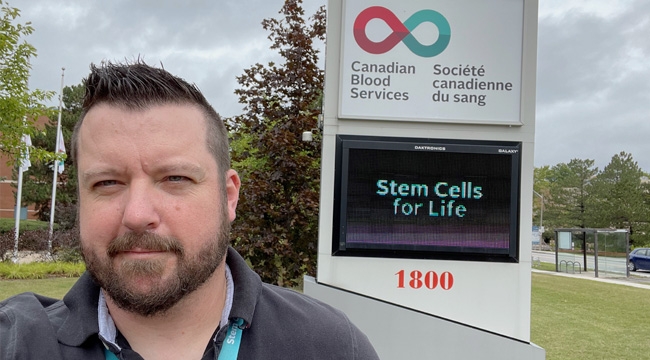Stem cell donors could be someone’s hope for life
Every year, hundreds of Canadian patients need life-saving stem cell transplants, and most rely on the generosity of an unrelated donor.
Every year, hundreds of Canadian patients need life-saving stem cell transplants, and most rely on the generosity of an unrelated donor. Found primarily in umbilical cord blood, peripheral circulating blood, and bone marrow; blood-forming stem cells are used to treat more than 80 diseases and disorders, such as leukemia, lymphoma, aplastic anemia, and sickle cell disease.
To significantly increase the odds of finding a matching stem cell donor for patients, the Canadian Blood Services Stem Cell Registry — the public registry responsible for recruiting and finding healthy, committed volunteer donors — belongs to an international network of registries to match potential donors and recipients around the world. For every patient who finds a match among their family, three will rely on a total stranger’s generous donation of life-saving stem cells. With almost 450,000 registrants and access to more than 35 million potential stem cell donors on this network, the odds of finding a match are much, much higher.
“If you donate cord blood or join the stem cell registry, you may save a life,” says Dr. Heidi Elmoazzen, Director of Stem Cells at Canadian Blood Services. It’s that simple. Yet, about half the registrants contacted to launch the actual donation process decline to proceed with the donation — a potentially devastating experience for the patient. This is why registrants are often reminded that joining the registry is a long-term commitment — it could be months or even years before they may be called to donate.
Seeking optimal, diverse donors
Patients are more likely to find a donor from within their own ancestral group. Also, patients of diverse ethnic or mixed-race backgrounds face a much steeper hill when searching for a stem cell match. This is why the stem cell registry specifically targets potential donors from diverse ethnic backgrounds who are also optimal donors — males aged 17 to 35.
Donating cord blood — the blood that remains in the umbilical cord and placenta after the birth of a healthy baby — is another way to help patients. Canadian Blood Services’ Cord Blood Bank launched in 2013 to provide expectant mothers the opportunity to donate to a national public cord blood bank at four hospital collection sites in Ottawa, Brampton, Edmonton, and Vancouver.
Join the registry; donate cord blood
Joining the Canadian Blood Services Stem Cell Registry involves a simple cheek swab and the understanding that this could be a long-term commitment. For pregnant moms living in a city with a designated cord blood collection hospital, you and your tiny hero could save lives by joining Canada’s Lifeline.
Read the full article published in Maclean’s October 2019 issue alongside the inspiring story of 6-year-old Hillary McKibbin, who was diagnosed with a rare blood disease called idiopathic aplastic anemia.



